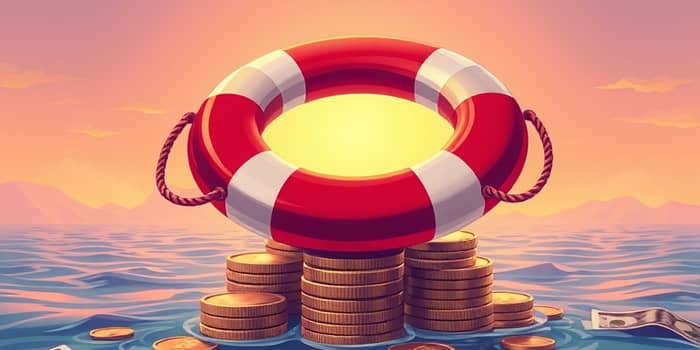Imagine waking up to a flooded basement, or receiving a call that you’ve lost your job unexpectedly. For many, these scenarios trigger panic and financial distress. But with an emergency fund in place, the impact can be dramatically reduced. At its core, an emergency fund is a dedicated savings account set aside exclusively to handle shocking and unplanned expenses.
This essential component of personal finance doesn’t just keep your lights on or car running; it provides a psychological buffer that enhances confidence and freedom. When the unexpected strikes, you gain the luxury of time to focus on recovery rather than scrambling for loans or high-interest credit. In this comprehensive guide, we will unpack the definition, purpose, and practical steps needed to establish and maintain this vital financial cushion.
Consider the story of Sarah, a freelance graphic designer who was three months behind on client payments when her car needed a major repair. Thanks to her emergency fund, she paid the mechanic immediately and continued working without the burden of high-interest credit. Stories like hers illustrate the transformative power of proactive savings.
Common Emergency Scenarios
Life rarely announces its challenges in advance. From medical crises to sudden home disasters, emergencies demand immediate financial resources. Understanding which events genuinely qualify ensures you preserve your fund for true emergencies:
- Severe medical expenses, including hospital stays and specialist consultations.
- Loss of employment or reduction in work hours that affects your income flow.
- Critical car repairs, collisions, or breakdowns that are not covered by insurance.
- Emergency repairs for home disasters like burst pipes, structural damage, or heating failure.
- Urgent travel requirements due to family illness or bereavement overseas.
By strictly reserving your fund for these unplanned crises, you build trust in your financial system—knowing that when real emergencies occur, help is already waiting in your savings.
How Much Should You Save?
Determining the right target for your emergency fund depends on various personal factors. While industry benchmarks offer a solid starting point, your unique circumstances may call for adjustment.
As a general rule, aim for three months’ worth of living expenses if you have stable employment and minimal financial dependents. This covers essential outlays such as rent or mortgage, utilities, groceries, insurance premiums, and transportation.
If you support children, elderly relatives, or have significant monthly obligations, increasing your goal to six months brings additional security. Those with unpredictable earnings—like freelancers, gig workers, or commission-based professionals—should consider a nine-month reserve to account for seasonal fluctuations.
Beyond time-based metrics, translate these guidelines into dollar figures that reflect your real budget. For example, if your monthly essentials total $2,500, a three-month cushion would be $7,500, while a nine-month fund would grow to $22,500.
National surveys reveal a startling reality: 56% of American adults wouldn’t cover a $1,000 emergency from savings, and over 35% lack funds for a $400 surprise bill without resorting to credit. These statistics underscore the critical need for adequate financial preparation. Tailor your objective to account for inflation, cost-of-living changes, and any upcoming life events that might affect your monthly outlays.
Step-by-Step Guide to Building Your Fund
Even if you feel stretched thin, taking consistent, small steps can build substantial emergency savings over time. Here’s a detailed roadmap to get started:
- Assess your baseline: Review the past three months of bank statements to calculate your average essential spending. Knowing your baseline expense is the first critical step.
- Establish micro-deposits: Treat your emergency fund like a recurring bill. Schedule weekly or bi-weekly transfers to a separate account before you have a chance to spend it.
- Cut unnecessary costs: Identify subscriptions, dining out, and impulse purchases that add up. Redirect those savings toward your fund.
- Leverage windfalls: Channel bonuses, tax returns, or monetary gifts directly into your emergency savings rather than discretionary spending.
- Monitor progress: Set incremental milestones—$500, $1,000, $5,000—and reward yourself with modest celebrations when you reach them.
Consistency is more important than speed. For example, setting aside $25 weekly translates to $1,300 in a year—an amount that could cover a minor medical bill or car repair without stress. Incorporating this habit into your financial routine will ensure gradual growth of your safety net.
Moreover, using automated systems means you automate deposits to pay yourself first, embedding your savings plan into your cash flow so you don’t have to remind yourself each payday.
Where to Keep Your Funds
The ideal emergency fund location combines accessibility, security, and modest returns. Here’s a closer look at the most popular options:
High-Yield Savings Accounts: Online banks often provide competitive interest rates that outpace traditional accounts. These allow you to earn extra without risking your balance, ensuring your cushion grows steadily over time.
Traditional Savings Accounts: Offered by brick-and-mortar banks or credit unions, these accounts provide physical branch access. While interest rates may be lower, convenience and integrated services can make them appealing.
Money Market Accounts: Combining features of checking and savings, these accounts sometimes allow limited check writing and offer interest rates between savings and checking accounts.
Always choose a liquid account with easy access that imposes few to no withdrawal penalties or monthly fees. Refrain from investing your emergency pot in stocks, bonds, or certificates of deposit with lock-up periods—you never know when you’ll need immediate liquidity.
Best Practices and Pitfalls
Maintaining an emergency fund requires both discipline and regular review. Follow these best practices to maximize its effectiveness:
Conduct quarterly audits to ensure your fund still matches your current cost of living. Life changes such as marriage, children, or relocation should prompt a reassessment of your savings target.
Be mindful of fees. Bank service charges, minimum balance penalties, or excessive ATM costs can quietly erode your emergency capital over time. Select accounts with transparent fee structures and consider switching if costs rise without commensurate benefits.
It’s critical to avoid reliance on high-interest debt. Credit cards, payday loans, and cash advances carry exorbitant rates that can trap you in a cycle of repayment. An adequately funded emergency reserve insulates you from these dangerous borrowing options.
Avoid common mistakes such as treating your reserve like a general-purpose savings account or dipping into it for non-urgent needs. This fund exists purely to shield you in moments of true crisis.
Recent Data and Statistics
Data from various financial institutions and government sources paint a clear picture of American households’ preparedness: 56% of adults cannot cover a $1,000 emergency expense from savings alone. 35% of adults lack sufficient funds for a $400 emergency without borrowing. Roughly two-thirds of Americans admit they would use a credit card or personal loan to handle unexpected costs. Just 23% of households have enough savings to meet a nine-month income gap.
These sobering numbers highlight both the prevalence of inadequate savings and the widespread vulnerability to even modest unforeseen expenses. They underscore the need to prioritize building a reliable emergency fund as part of every household’s financial plan.
Conclusion
Establishing an emergency fund is not merely a recommendation—it’s a fundamental pillar of financial resilience. By securing at least three months of expenses, and adjusting that number upward based on dependents or variable income, you achieve a level of confidence that permeates every other aspect of your life.
Start today by analyzing your essential expenditures, setting achievable savings targets, and selecting the right account to hold your funds. Remember that small, consistent efforts can accumulate into a substantial cushion. With the discipline to contribute regularly and the commitment to treat this reserve as sacred, you will preserve long-term financial well-being and approach life knowing you have a dependable safety net ready for any challenge.
Additional Financial Safety Nets
- Comprehensive health, auto, and homeowners or renters insurance.
- Government assistance programs tailored to income fluctuations.
- Dedicated retirement savings plans—though they should not replace an emergency reserve.
References
- https://www.mycvcu.org/blog/importance-of-building-an-emergency-fund
- https://www.bankeasy.com/personal/customer-resources/what-is-a-good-amount-for-an-emergency-fund
- https://www.northshorebank.com/about-us/connecting-with-you/budgeting/pros-and-cons-of-having-an-emergency-fund
- https://www.nerdwallet.com/article/banking/emergency-fund-calculator
- https://www.nerdwallet.com/article/banking/emergency-fund-why-it-matters
- https://www.tiaa.org/public/learn/financial-education/building-an-emergency-fund
- https://www.fidelity.com/learning-center/smart-money/emergency-fund
- https://www.wellsfargo.com/financial-education/basic-finances/manage-money/cashflow-savings/emergencies/










